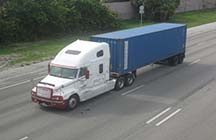 |
 |
|
| eNews • November 2013 | ||
| Promoting a Cost-Effective, Reliable and Competitive Transportation System |
||

The messengers were more important than the message when a special U.S. House panel, following six months of hearings and logistics site visits, recommended spending more on freight transportation.
That Congress wants to increase investment to make shippers more globally competitive but is kicking the can on how to pay for better ports, highways and inland waterways is hardly novel. But that a bipartisan group of 11 House members could get behind a plan not only backing more spending but open to new funding sources, including hiking fuels taxes and charging freight fees, is encouraging, said Mortimer Downey, a former Department of Transportation deputy secretary.
To shippers and transportation providers, the position may seem like a no-brainer. In Washington, however, the report from the Panel on 21st Century Freight Transportation is a sharp rebuke of some conservative Republicans who argue federal infrastructure spending can be wound down and states can take up more of the burden. The House’s passage of a water resources bill authorizing port and inland waterway projects last month only adds to infrastructure advocates’ optimism. “There isn’t a lot new in this report,” said Downey, chairman of the Coalition for America’s Gateways and Trade Corridors. “What’s new about it is who is saying it.”
Still, even if there is stronger House support for infrastructure spending than when the chamber failed to pass its own version of a surface transportation bill last year, the funding challenges are even greater. The Highway Trust Fund, the main engine of federal surface transportation funding, will become insolvent in fiscal 2015, and budget offsets, or pay-fors, that helped the last bill bridge the trust fund shortfall are scarcer. The existing $109 billion, roughly two-year surface transportation bill, Moving Ahead for Progress in the 21st Century, or MAP-21, expires at the end of September 2014.
Rep. John Duncan Jr., R-Tenn., said the panel didn’t make funding recommendations on how to improve freight infrastructure because the panel couldn’t cover every issue. Duncan, the panel chairman, did, however, emphasize that many in the trucking and barge industries support paying higher taxes or fees if they get better highways and inland waterways, respectively, in return. Aside from reviewing older recommendations from past panels and commissions to hike the fuels tax, the House report also highlights four options to pay for freight projects: customs duties and fees, a freight waybill tax, a weight distance tax and a container tax. Those new revenue sources could provide steady funding for the Project of National and Regional Significance program, a program like the TIGER grant program but aimed at even larger projects. The panel emphasized its desire to reinvigorate the PNRS program, which received one-time funding in the 2005 surface transportation bill but didn’t get the $500 million authorized in MAP-21.
The Senate doesn’t appear to be any farther in figuring out how to increase, or at least maintain, surface infrastructure spending through the next surface transportation. Sen. Barbara Boxer, D-Calif., in September pitched replacing the federal fuels tax with a sales tax on oil at refineries. But the head of the Environment and Public Works Committee gave few details on how the scheme would work other than it could be incorporated into a tax reform bill, omnibus legislation or some other type of grand package.
The lack of progress is putting more of the onus on the Obama administration to pitch a funding fix. The House panel, in fact, directs DOT Secretary Anthony Foxx to work with the secretaries of the Treasury and the Army to find and recommend sustainable sources of freight infrastructure revenue. Some argue the move is just passing the buck, but CAGTC Executive Director Leslie Blakey sees the move as a sign of willingness to collaborate with the Obama administration on finding a solution.
So far, the Obama administration — busy with the partial government shutdown, the Syrian civil war and a botched healthcare website rollout — hasn’t offered anything but familiar calls for more spending. Interestingly, former DOT Secretary Ray LaHood, newly freed from Obama administration oversight, has been stumping for a fuels tax hike.
Transportation funding wasn’t the only issue the House freight panel ducked. Instead of weighing in on the debate over raising the size and weights of trucks, members just encouraged DOT to complete its study on the issue. The House report didn’t stray into the debate over freight rail reform, either, despite Eddie Johnston, transportation policy leader at DuPont, telling panel members that reforms, such as allowing competitive switching, would make U.S. exporters more competitive.
The most concrete outcome of the House report could be that it gives the DOT the go-ahead to include railroads and inland waterways in its national freight network. Congress in MAP-21 directed the agency to designate a network of up to 27,000 miles, but rails and rivers weren’t included. The panel “recognizes that we can’t just look at freight when it’s on the back of a truck,” said T&I Ranking Member Nick Rahall, D-W. Va. Hardly a groundbreaking realization for those in the private sector, but a small step just the same.
Source: Journal of Commerce
Soy Transportation Coalition |
|
